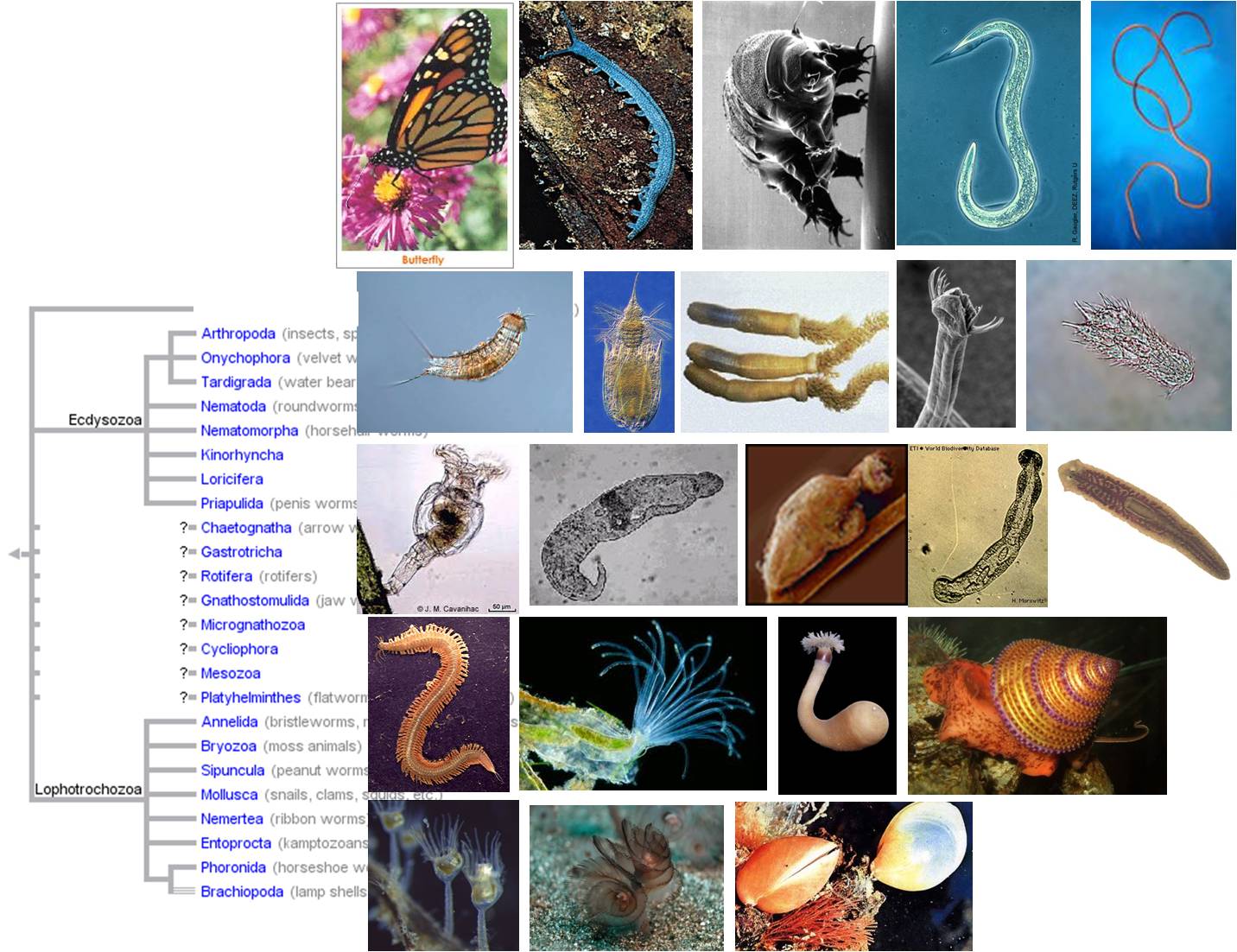 The
Diversity of Life
The
Diversity of Life  The
Diversity of Life
The
Diversity of Life
l. Phylum Chordata: Vertebrates

Vertebrates represent the evolutionary lineage that went in the other direction: not towards a sedentary lifestyle but towards an active lifestyle. For the remainder of this unit, we will look at the evolutionary radiations within the vertebrates. We will see a typical pattern throughout this unit. A new group will evolve a novel trait or way of life. This will allow it to use a new environment, or use the environment in a new way. These lifestyles are called "adaptive zones", and they relate to ecological niches. Creation or entry into a new niche or zone means that there is no competition for resources. Under these conditions, almost any strategy using this new novel innovation will work - typically we see a radiation of new species exploiting this new way of life. As this adaptive zone or niche fills with species, they begin to compete. This leads to 'competitive contraction' of diversity, with only a few winners. The same thing happens in any situation where there are potentially limted resources. A new innovation, like the internet, provides opportunities to new businesses. Many flourish initially - like the many browser providers that were present in the '90's. Anyone remember when Netscape was the primary internet provider? Economists call that period the "dot-com boom", when internet companies could get a start just by colonizing this new open marketplace. As companies grew, they began to compete; and there were winners that maintained their position in the niche, and losers that went extinct. The same thing can happen in ecological systems. Competitive contraction can occur within a clade, or as a consequence of a more efficient, new evolutionary novelty arising. Henry Ford's Model T not only put many other car makers out of business, it also puts LOTS of horse-driven carriage companies out of business! So, as a more advanced, efficient group evolves, we sometimes see contraction in the abundance of ancestral forms... just as Darwin predicted.
 The
jawless fishes: The vertebrates are distinguished by having an internal supportive spine that
is subdivided into units called vertebrae. This segmentation of the vertebral
column allows the animal to bend and move with more precision; with some parts
of the body moving while other parts remain stationary. The most primitive members
of this clade are the jawless fishes. The modern representatives are the hagfish
and the lampreys. The hagfish actually lack a subdivided vertebral column, but
they do have a skull surrounding their brain. As such, sometimes the "vertebrata"
are more specifically described as having a skull (to include the hagfish).
Both hagfish and lampreys have immature stages that look almost identical to
cephalochordates, also suggesting their primitive position within this clade.
So, the jawless fish evolve in the Cambrian and radiate in the Ordovician and
Silurian Periods, with many large, detritivorous and filter feeding species
scouring the benthos for food. In more advanced forms, the mouth cavity and
pharynx evolved for feeding, relieving the gills of this filtering function.
These jawless fish probably sucked in small invertebrates by rapidly opening
their mouth.
The
jawless fishes: The vertebrates are distinguished by having an internal supportive spine that
is subdivided into units called vertebrae. This segmentation of the vertebral
column allows the animal to bend and move with more precision; with some parts
of the body moving while other parts remain stationary. The most primitive members
of this clade are the jawless fishes. The modern representatives are the hagfish
and the lampreys. The hagfish actually lack a subdivided vertebral column, but
they do have a skull surrounding their brain. As such, sometimes the "vertebrata"
are more specifically described as having a skull (to include the hagfish).
Both hagfish and lampreys have immature stages that look almost identical to
cephalochordates, also suggesting their primitive position within this clade.
So, the jawless fish evolve in the Cambrian and radiate in the Ordovician and
Silurian Periods, with many large, detritivorous and filter feeding species
scouring the benthos for food. In more advanced forms, the mouth cavity and
pharynx evolved for feeding, relieving the gills of this filtering function.
These jawless fish probably sucked in small invertebrates by rapidly opening
their mouth.
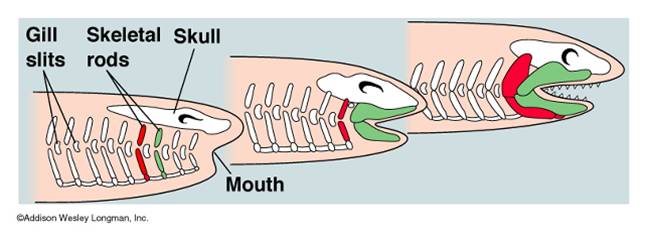 The
Gnathostomes: The Jawed Vertebrates: Jawed fishes evolved
in the Silurian and came to dominate and radiate in the Devonian - the "Age
of Fishes". Jaws evolved from the anterior gill arches, which flex and
became associated withe the mouth. Jaws allowed fish to become more efficient
predators, killing things bigger than could fit in their mouth through suction,
or strong enough to escape the suctioning force. In short, jaws were adaptive
because fish now became mobile, active predators - entering a niche previously
only occupied by large invertebrate predators. The first jawed fish radiation
were the placoderms, symbolized by the frightening Arthrodire predators like Dunkleosteus, with its huge slicing jaw plates. The placoderms were
very heavy, however, and were displaced by more efficient swimmers - the cartilaginous
jawed fishes (Class Chondrichthyes). Modern representatives of this group are
sharks and rays.
The
Gnathostomes: The Jawed Vertebrates: Jawed fishes evolved
in the Silurian and came to dominate and radiate in the Devonian - the "Age
of Fishes". Jaws evolved from the anterior gill arches, which flex and
became associated withe the mouth. Jaws allowed fish to become more efficient
predators, killing things bigger than could fit in their mouth through suction,
or strong enough to escape the suctioning force. In short, jaws were adaptive
because fish now became mobile, active predators - entering a niche previously
only occupied by large invertebrate predators. The first jawed fish radiation
were the placoderms, symbolized by the frightening Arthrodire predators like Dunkleosteus, with its huge slicing jaw plates. The placoderms were
very heavy, however, and were displaced by more efficient swimmers - the cartilaginous
jawed fishes (Class Chondrichthyes). Modern representatives of this group are
sharks and rays.
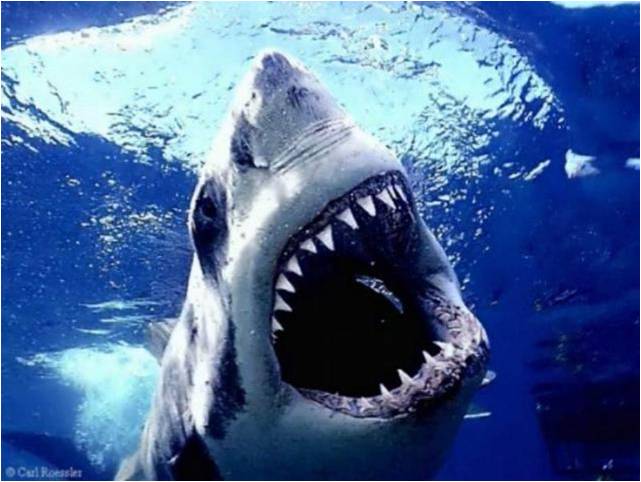 The
Devonian also saw the radiation of the most successful group of fish on earth,
the bony fish (Class Osteichthyes). Unlike cartilage, bone is hollow and light;
it is also more rigid than cartilage, providing more resistance and efficiency
to muscles. The bony fish also had a swim bladder, whcih they used to maintain
neutral bouyancy in the water column. This means that they can maintain position
without swimming; Condrichthyes must swim to maintain vertical position in the
water column - otherwise they sink. These two adaptations of the bony fishes
made them more energetically efficient and faster than the cartilaginous fish,
and the bony fishes have radiated to the point where they represent 40% of all
vertebrate species today (not just fish - vertebrates..!!). Two important clades
evolved within the bony fishes: 1) the ray-finned fishes that came to dominate
the aquatic environments of the planet; and 2) the lob-finned fishes that radiated
into shallow-water environments. The lobe-finned fishes, swimming in shallow,
oxygen-poor waters of the Devonian, gulping air at the surface and pulling themselves
along on their forefins, evolved into the terrestrial tetrapods. Arthropods
had already colonized land, so there was ample food and oxygen for a large terrestrial
predator. As you have seen, the fossil record nicely documents the transition
from fish to these primitive amphibians.
The
Devonian also saw the radiation of the most successful group of fish on earth,
the bony fish (Class Osteichthyes). Unlike cartilage, bone is hollow and light;
it is also more rigid than cartilage, providing more resistance and efficiency
to muscles. The bony fish also had a swim bladder, whcih they used to maintain
neutral bouyancy in the water column. This means that they can maintain position
without swimming; Condrichthyes must swim to maintain vertical position in the
water column - otherwise they sink. These two adaptations of the bony fishes
made them more energetically efficient and faster than the cartilaginous fish,
and the bony fishes have radiated to the point where they represent 40% of all
vertebrate species today (not just fish - vertebrates..!!). Two important clades
evolved within the bony fishes: 1) the ray-finned fishes that came to dominate
the aquatic environments of the planet; and 2) the lob-finned fishes that radiated
into shallow-water environments. The lobe-finned fishes, swimming in shallow,
oxygen-poor waters of the Devonian, gulping air at the surface and pulling themselves
along on their forefins, evolved into the terrestrial tetrapods. Arthropods
had already colonized land, so there was ample food and oxygen for a large terrestrial
predator. As you have seen, the fossil record nicely documents the transition
from fish to these primitive amphibians.
 The
Tetrapods: The
tetrapod clade includes all vertebrates descended from the first animals to
walk on land. The radiation of early tetrapods is very impressive; the adaptive
zone of the Carboniferous swamps was very large and well-suited to amphibian
animals reliant on water to lay their eggs. In addition, the huge amount of
biological productivity (lots of photosynthesis and less decompostion, remember?)
led to large populations of herbivorous insects that were eay prey for large
land vertebrates. The Carboniferous could well be called the "Age of Amphibians".
Many groups of early 'amphibians' radiate during this period, collectively called
the 'stem tetrapods'. However, the dry periods of the Permian and Mesozoic were
not optimal for these animals limited to areas near water. Today, three groups
of amphibians remain. The Caecilians are unusual, rare, legless amphibians.
Salamanders are the second group, and the giant Japanese salamander is the largest
living amphibian - reaching six feet in length! The most diverse group is the
Anura - mening "tailless" - the frogs and toads. Most amphibians have
gills or lungs at some point in their life cycle, but many also (or exclusively)
respire through their skin. For this to happen, the gases must diffuse into
a thin film of water, and then move across cell membranes by diffusion. So,
most amphibians need to keep their skin moist to respire; and it also means
that their skin, as an absorptive surface, is also prone to absorb toxins in
the environment. For these reasons, amphibians are particularly sensitive to
pollutants and environmental contaminants. Over the last 50 years, there has
been a dramatic decline in amphibian populations worldwide, probably due to
exposure to human-produced pollution, climate change, and chytrid fungal infections.
It is tough to say which of these variables is 'most' responsible for the decline.
In all likelihood, each factor increases sensitivity to the other two. In any
case, these three factors are having a decimating effect on amphibian populations.
The
Tetrapods: The
tetrapod clade includes all vertebrates descended from the first animals to
walk on land. The radiation of early tetrapods is very impressive; the adaptive
zone of the Carboniferous swamps was very large and well-suited to amphibian
animals reliant on water to lay their eggs. In addition, the huge amount of
biological productivity (lots of photosynthesis and less decompostion, remember?)
led to large populations of herbivorous insects that were eay prey for large
land vertebrates. The Carboniferous could well be called the "Age of Amphibians".
Many groups of early 'amphibians' radiate during this period, collectively called
the 'stem tetrapods'. However, the dry periods of the Permian and Mesozoic were
not optimal for these animals limited to areas near water. Today, three groups
of amphibians remain. The Caecilians are unusual, rare, legless amphibians.
Salamanders are the second group, and the giant Japanese salamander is the largest
living amphibian - reaching six feet in length! The most diverse group is the
Anura - mening "tailless" - the frogs and toads. Most amphibians have
gills or lungs at some point in their life cycle, but many also (or exclusively)
respire through their skin. For this to happen, the gases must diffuse into
a thin film of water, and then move across cell membranes by diffusion. So,
most amphibians need to keep their skin moist to respire; and it also means
that their skin, as an absorptive surface, is also prone to absorb toxins in
the environment. For these reasons, amphibians are particularly sensitive to
pollutants and environmental contaminants. Over the last 50 years, there has
been a dramatic decline in amphibian populations worldwide, probably due to
exposure to human-produced pollution, climate change, and chytrid fungal infections.
It is tough to say which of these variables is 'most' responsible for the decline.
In all likelihood, each factor increases sensitivity to the other two. In any
case, these three factors are having a decimating effect on amphibian populations.
The Amniota: Within the tetrapods, a new type of animal evolved in the Carboniferous; an animal that laid an egg surrounded by a series of membranes and a shell. These layers served to protect the developing embryo and yolk sac from dessication, allowing these species to colonize land further from water and exploit food resources and habitats that amphibians could not reach. This clade of animals is the amniotes, and their evolutionary innovation is the amniotic egg. The primitive condition within this group probably produced a leathery covering, much like turtles. A more rigid, desiccation resistant egg like birds have is probably a derived trait, as is the retention of the egg and live bearing of young, as seen in some snakes, and most mammals. The amniotes radiated during the Permian Period, when the drying of the unified land mass of Pangaea gave them a decided advantage over the ancestral, amphibious tetrapods. Three groups evolved at this time, distinguished by their skull morphology.
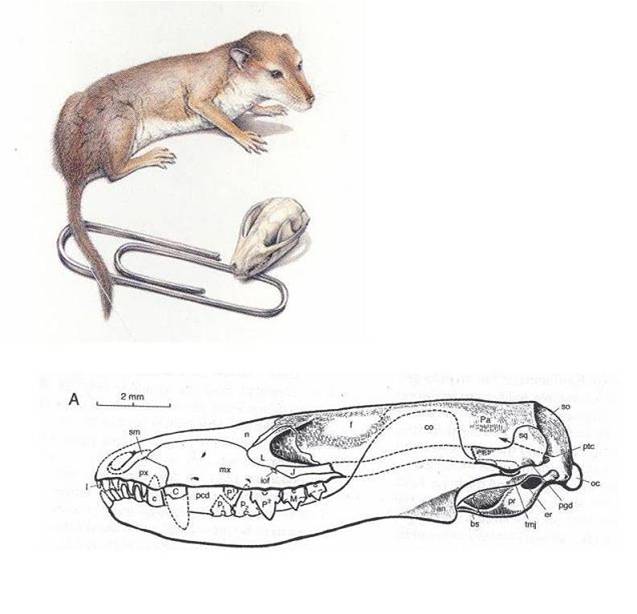 The
Synapsids and the Mammals: The first group to dominate
were the synapsids. They dominated during the Permian, and were represented
by the great "sail-finned" Pelycosaurs and the Therapsid lineages
(the Gorgonopsians, the Dicynodonts, and the Cynodonts). The synapsid lineage
that is alive today are the Mammals. The transition from ancestral to derive
synapsids is well preserved in the fossil record, documenting the evolution
of the inner ear from the ancestral jaw bones, and the evolution of complex
and specialized dentition. The first true mammals are the Morganucodonts that
evolved in the Jurassic Period of the Mesozoic, about 200 mya. Ancestral synapsids
were large carnivores that dominated the landscape; a niche that would be filled
by the diapsid dinosaurs during the Mesozoic. The mammals were small, noctural
insectivores and scavengers. They radiated into these niches in the Jurassic,
perhaps because their endothermy allowed them to use the cool night more effectively
and under cover of darkness from larger predators. The surviving lineage of
this radiation are the three species of monotremes alive today: the platypus
and two species of echidna. These mammals lay eggs. Their offspring hatch, and
then nuzzle the belly of their mothers. Their mothers have sweat glands that
have evolved to produce a nutrient rich milk - they are mammary glands. However,
even the modern representatives lack nipples on these glands - so they "sweat"
milk onto their belly and the the hatchlings lick it up. Placental and marsupial
mammals evolved later, in the Cretaceous Period. Marsupials do not lay eggs;
they give live birth to a very small, embryonic newborn. The newborn climbs
from the genital opening to the pouch - a flap of skin covering the nipples
of the mammary glands. The embryo attaches to a nipple and feeds nearly continuously,
completing development in the pouch. This allows the mother to carry the embryo
with her for a longer period; there are no eggs that must be left periodically
for the mother to feed. The last group of mammals, the placentals, also retain
the embryo and give live birth. However, they retain the embryo much longer,
often until the offspring is capable of independent activity. The efficient
feeding of the embryo is facilitated by the placenta - which allows nutrients
in the bloodstream of the mother to pass directly into the bloodstream of the
offspring. This is far more efficient, energetically, than the mother turning
the nutrients into milk, that must be consumed and digested by the offspring.
So, placental mammals can develop more rapidly than marsupials. Some placentals
produce offspring that can walk immediately; these are precocial young. Other
species, like cats and humans, produce offspring that still need considerable
parental care. These offspring are called altricial.
The
Synapsids and the Mammals: The first group to dominate
were the synapsids. They dominated during the Permian, and were represented
by the great "sail-finned" Pelycosaurs and the Therapsid lineages
(the Gorgonopsians, the Dicynodonts, and the Cynodonts). The synapsid lineage
that is alive today are the Mammals. The transition from ancestral to derive
synapsids is well preserved in the fossil record, documenting the evolution
of the inner ear from the ancestral jaw bones, and the evolution of complex
and specialized dentition. The first true mammals are the Morganucodonts that
evolved in the Jurassic Period of the Mesozoic, about 200 mya. Ancestral synapsids
were large carnivores that dominated the landscape; a niche that would be filled
by the diapsid dinosaurs during the Mesozoic. The mammals were small, noctural
insectivores and scavengers. They radiated into these niches in the Jurassic,
perhaps because their endothermy allowed them to use the cool night more effectively
and under cover of darkness from larger predators. The surviving lineage of
this radiation are the three species of monotremes alive today: the platypus
and two species of echidna. These mammals lay eggs. Their offspring hatch, and
then nuzzle the belly of their mothers. Their mothers have sweat glands that
have evolved to produce a nutrient rich milk - they are mammary glands. However,
even the modern representatives lack nipples on these glands - so they "sweat"
milk onto their belly and the the hatchlings lick it up. Placental and marsupial
mammals evolved later, in the Cretaceous Period. Marsupials do not lay eggs;
they give live birth to a very small, embryonic newborn. The newborn climbs
from the genital opening to the pouch - a flap of skin covering the nipples
of the mammary glands. The embryo attaches to a nipple and feeds nearly continuously,
completing development in the pouch. This allows the mother to carry the embryo
with her for a longer period; there are no eggs that must be left periodically
for the mother to feed. The last group of mammals, the placentals, also retain
the embryo and give live birth. However, they retain the embryo much longer,
often until the offspring is capable of independent activity. The efficient
feeding of the embryo is facilitated by the placenta - which allows nutrients
in the bloodstream of the mother to pass directly into the bloodstream of the
offspring. This is far more efficient, energetically, than the mother turning
the nutrients into milk, that must be consumed and digested by the offspring.
So, placental mammals can develop more rapidly than marsupials. Some placentals
produce offspring that can walk immediately; these are precocial young. Other
species, like cats and humans, produce offspring that still need considerable
parental care. These offspring are called altricial.
The Diapsids: The other major group of amniotes are the diapsids. They radiated into two major groups, the lepidosaurs that walked with their legs splayed out and the archosaurs that walked with their legs underneath.
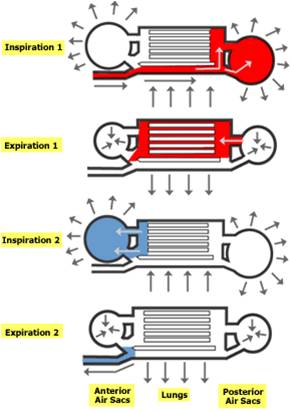 The
archosaurs would dominate during the Mesozoic Era, with the great
radations of the Crocodylomorphs, Pterosaurs, and Dinosaurs. Two groups of Archosaurs
persists today - the crocodilians (caimen, gavials, alligators, and crocodiles),
and the birds. Although several groups of dinosaurs evolved feathers - probably
first for attracting mates or communicating, and then for insulation - only
in the birds did these feathers evolve for powered flight. Associated shared
derived characters are light, hollow, fused bones, the fusion of digits in the
forelimbss, a keeled sternum for anchoring large breast muscles used for flight,
and a 'wishbone' - a union of the two clavicles that acts like a spring during
the flight stroke. The loss of teeth is also a derived trait in this group,
as is the evolution of an interesting respiratory system of air sacs. Birds
have a one way lung. Air that's inhaled goes to a posterior air sac. On the
first exhalation, air is moved forward through the lung. The second inhalation
refills the posterior air sac, and the next exhalation pulls deoxygenated air
forward into the anterior air sac and out of the animal. This modification,
like a one-way digestive tract, improves the efficiency of the organ. Now, the
air in the lung is always oxygenated; it is not mixed with deoxygenated air
like in the sac-like lungs of other animals. It's not surprizing that birds
would evolve this system, as the metabolic demands of flight are much more significant
than other forms of locomotion.
The
archosaurs would dominate during the Mesozoic Era, with the great
radations of the Crocodylomorphs, Pterosaurs, and Dinosaurs. Two groups of Archosaurs
persists today - the crocodilians (caimen, gavials, alligators, and crocodiles),
and the birds. Although several groups of dinosaurs evolved feathers - probably
first for attracting mates or communicating, and then for insulation - only
in the birds did these feathers evolve for powered flight. Associated shared
derived characters are light, hollow, fused bones, the fusion of digits in the
forelimbss, a keeled sternum for anchoring large breast muscles used for flight,
and a 'wishbone' - a union of the two clavicles that acts like a spring during
the flight stroke. The loss of teeth is also a derived trait in this group,
as is the evolution of an interesting respiratory system of air sacs. Birds
have a one way lung. Air that's inhaled goes to a posterior air sac. On the
first exhalation, air is moved forward through the lung. The second inhalation
refills the posterior air sac, and the next exhalation pulls deoxygenated air
forward into the anterior air sac and out of the animal. This modification,
like a one-way digestive tract, improves the efficiency of the organ. Now, the
air in the lung is always oxygenated; it is not mixed with deoxygenated air
like in the sac-like lungs of other animals. It's not surprizing that birds
would evolve this system, as the metabolic demands of flight are much more significant
than other forms of locomotion.
The Lepidosaurs also radiated during the Mesozoic, but did not do so as dramatically as the Archosaurs. Today, the surviving representatives are the Squamata (lizards and the derived snakes) and their sister group, the Sphenodonts with two surviving relict species of Tuatara native to New Zealand. The tuatara maintains the most primitive amniote characteristics, and so is very valuable in studying the phylogeny of diapsid reptiles. The derived squamates, the modern lizards and snakes, have scales, a double hinged jaw (particularly important in snakes), and a hinge on the top of their skull.
Things to Know:
1. Know the adaptive benefits of jaws, colonizing land, and an egg.
2. Know the reproductive differences among the monotremes, marsupials, and placentals. What advantages were there for marsupial and then placental reproductive strategies?
3. Know how a bird's respiratory system is more efficient than a mammal's, and how the evolution of feathers for flight may have occurred.
Study Question:
1. What was happening to tectonic plates in the Permian, and why did this gie an advantage to the amniotes?